Outdoor aviaries can be extremely beneficial for your companion bird, providing fresh air, natural sunlight and a large safe space for play. This blog discusses the aspects involved in designed an outdoor aviary that will provide a secure and safe environment for your parrot to play in.
Legal Requirements
Before you start planning and buying the materials for your aviary check with your local council in regards to the legal requirements surrounding the building of a potentially large obstructive structure in your back garden.
- You may require a permit.
- If you a planning on building the aviary as an extension to your house you will be required to follow the building regulations of your local council.
- If you live in a rented property it would be advisable to contact your landlord/landlady for permission prior to the construction. Even if the aviary is dismantlable you may face a contract dispute if your tenancy states you cannot make any notable changes to the layout of the house and the outside spaces.
- Consult with your neighbours – when it comes to making significant changes to the display of your house your neighbours will usually be your biggest objectors, especially if it is obstructing their view.
- Talk to your neighbours prior to planning your aviary – will they have an issue with where you are planning on putting it and will they have an issue with the noise. A playful parrot can be a noisy parrot.
Considerations
When drawing up the initial planning of your aviary consider,
- Materials – make sure the materials you use are safe (non-toxic) for your bird, and are hard wearing and will last against adverse weather and most importantly your parrot’s destructive behaviours.
- Size – does the size of the aviary at least meet the minimum requirements for the number and/or species of parrots you intend to have.
- Location – where is your aviary going to be built? Is it obstructing anything? How close will the aviary be to your neighbours?
- Design – your design should minimize maintenance, maximize cleanliness and maximize safety. An easy to clean aviary will prevent the build-up of harmful bacteria.
- Essentials – what additional features will be added to the aviary to provide the essentials such as places to perch and source of food and water.
- Shelter – the ideal aviary has an indoor/covered space to allow your birds a place of shade and protection from adverse weather. Will it have a heat source for winter?
- Predators – the design should prevent access from predators both flighted and ground dwelling, such as hawks, cats, squirrels, rats.
- Escape – your aviary should have a double / safety door system to prevent escape as even the most well trained parrot can be spooked into a panicked flight.
- Enrichment – what else can you add to the aviary to make it fun for your parrots – such as parrot safe shrubs and trees, hanging baskets full of parrot edible flowers and herbs, ropes, swings etc.
- Security – are the construction and location secure ? What can you do to deter theft of the birds – e.g. security lights, padlocks on aviary doors, a secure garden, plenty of privacy so people can’t see into the garden.
Materials
Safe Materials include:
- Non pressure treated or stained lumbar e.g. plain pine, hard wood such as red .grandis.
- Stainless steel, aluminium. powder coated iron.
- PVC piping
- Untreated natural fibre ropes (cotton, sisal and hemp).
- Non- treated wood free from pesticides, fungicides, herbicides, moulds and fungus (pine, balsa, birch, basswood, poplar, maple, walnut, ash, apple, elm, cactus, manzanita, rose, ribbon, sycamore, willow, cork, bamboo, and palm tree).
- Leather
- Acrylic (supervised!).
Toxic materials include:
- Non-stick coating (Teflon) and Polytetrafluoroethylene (PTFE)
- Lead, zinc, nickel, copper or anything galvanized.
- Insecticides, fungicides, pesticides and herbicides such as snail bait, rat poison and ant killer.
For a full list of all TOXIC household substances please see further reading.
Size and location
Size
Ideally you want your aviary to be as big as possible to allow your bird to spread its wings and fly however it is understandable that not everybody has the space for an arena sized, netted dome. There are however minimum requirements to ensure your bird is not restricted. The aviary must be a minimum of 2x the wingspan of the bird in length and 1.5x the wingspan for both depth and height of the aviary. If more than one bird is housed in the aviary the length, depth and height must be increased by 5% for every additional bird over two birds.
Location
The aviary should be situated away from fences and overhanging trees to prevent ease of access from predators, your aviary becoming a litter box for wild birds, squirrels etc… or potentially becoming a battering ram for fallen branches/fences in heavy winds.
It should be situated at a suitable distance away from your neighbours property to prevent any noise or obstruction complaints occurring and not in close contact with drainage pipes to prevent water overflowing into the aviary, or, close to exhaust vents to prevent hot air burns and inhalation of harmful gases.
Consider how the weather will affect your bird with the aviary in your chosen location. In times where daily temperatures soar will this area become too hot? Even with shelter from direct sunlight your bird can become seriously ill if left in an area of sweltering heat for long periods of time. Therefore the aviary should be placed in an area where air circulates to prevent overheating and placed away from areas that are in direct sunlight. What about in the winter? How will you protect the birds from the cold and wind? Polycarb insulated sheets can be affixed to the outside to provide protection from the elements.
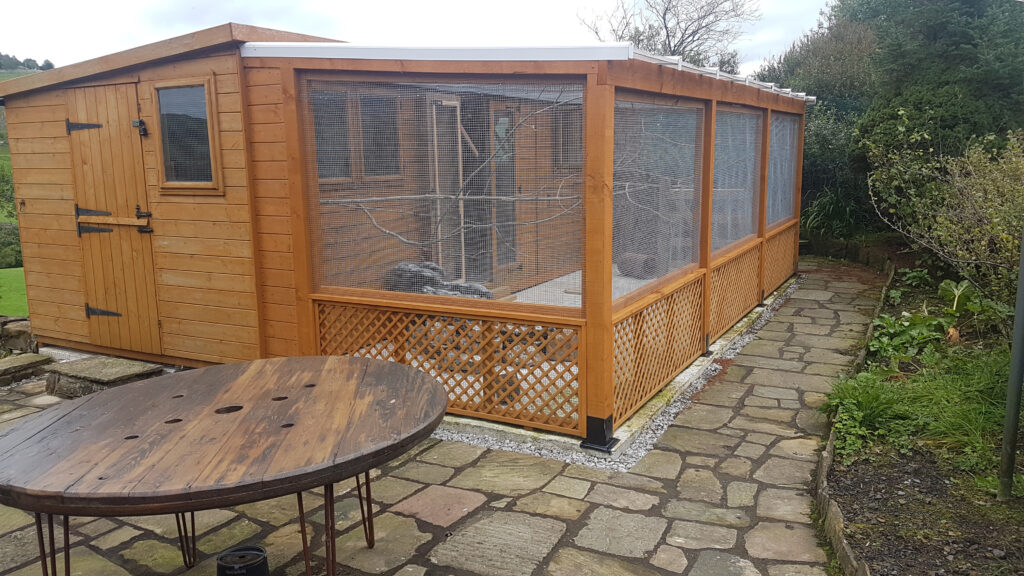
Aviary with external area, internal bird room and safety porch which doubles as a prep space. 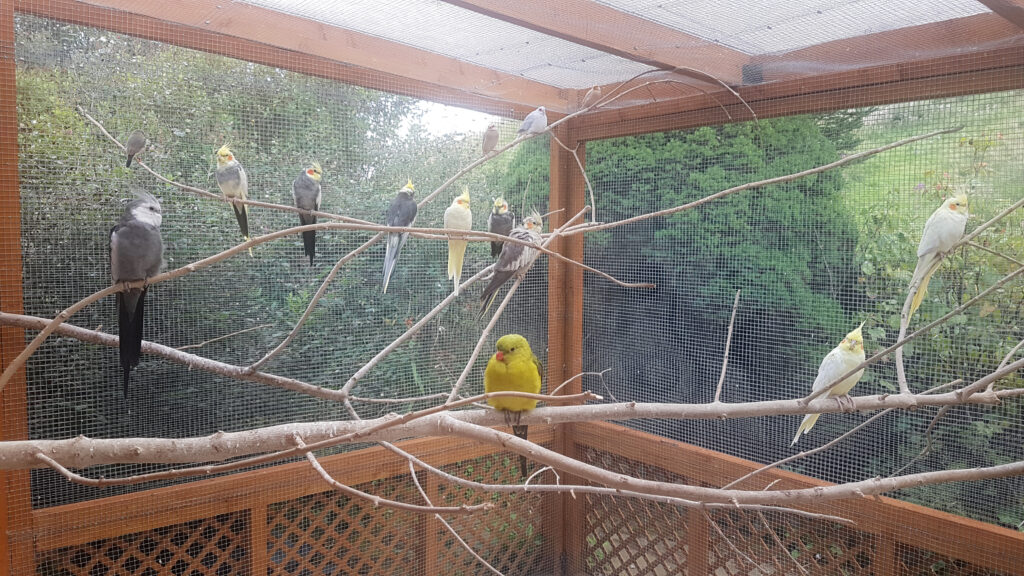
Natural perches 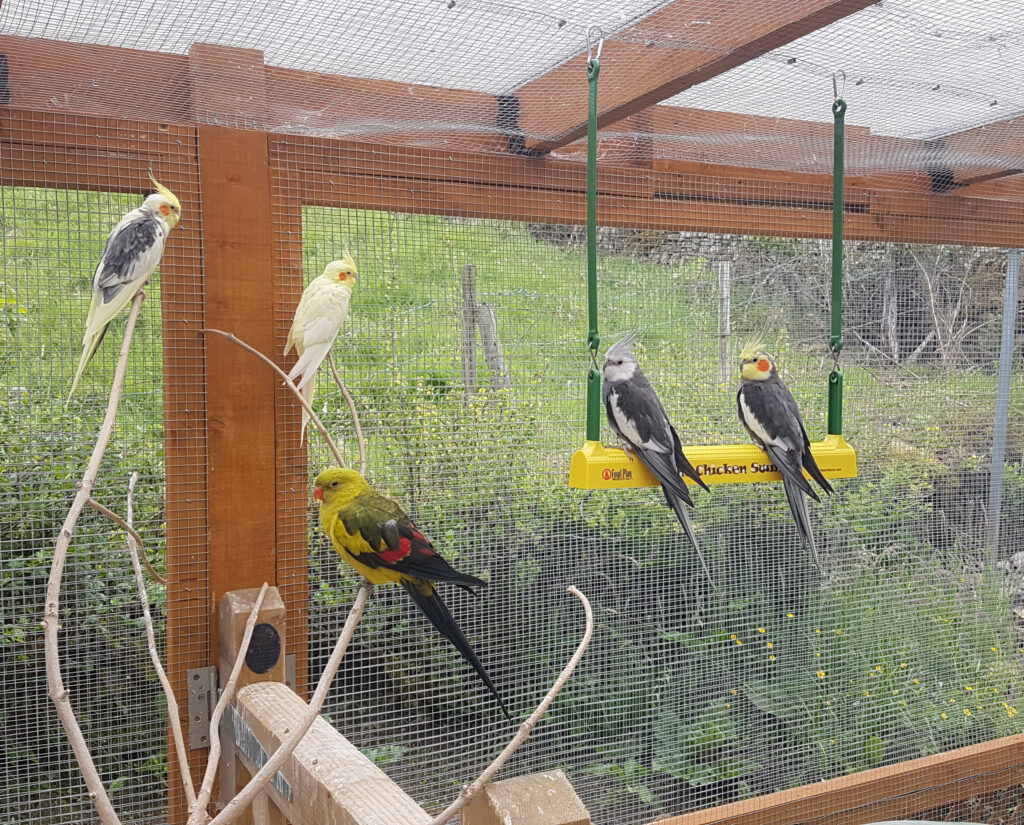
Ropes and swings make fun perches 
A variety of textures and different diameter perches are required to ensure birds exercise their feet. 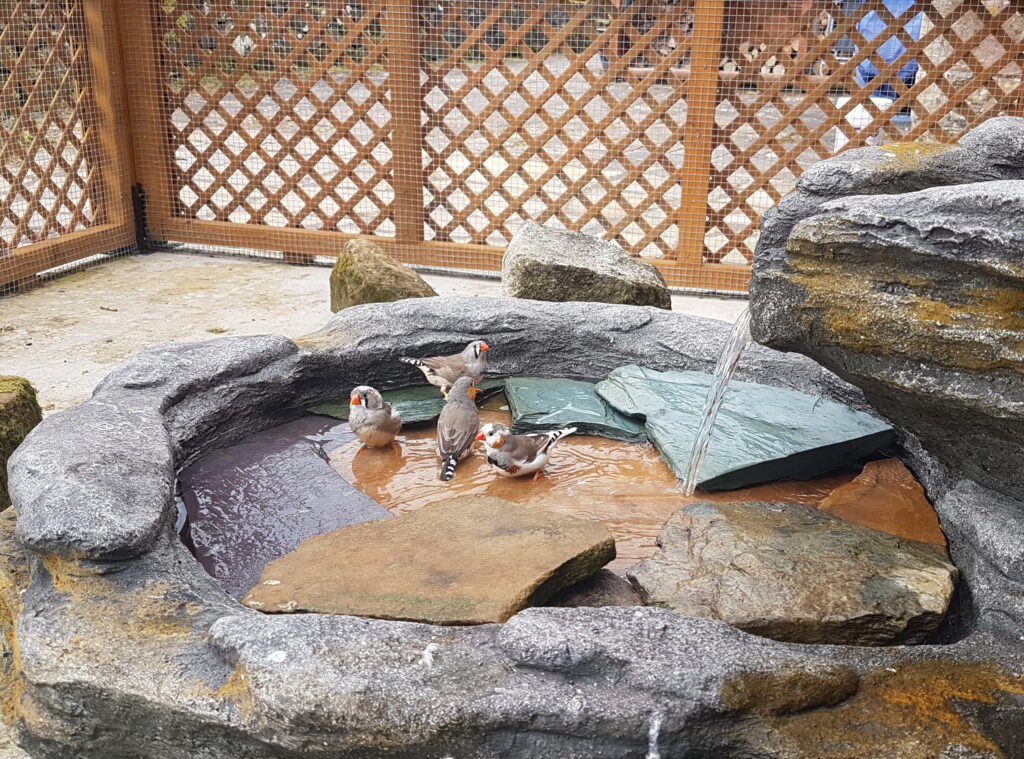
A water source purely for bathing is a great way to provide enrichment. 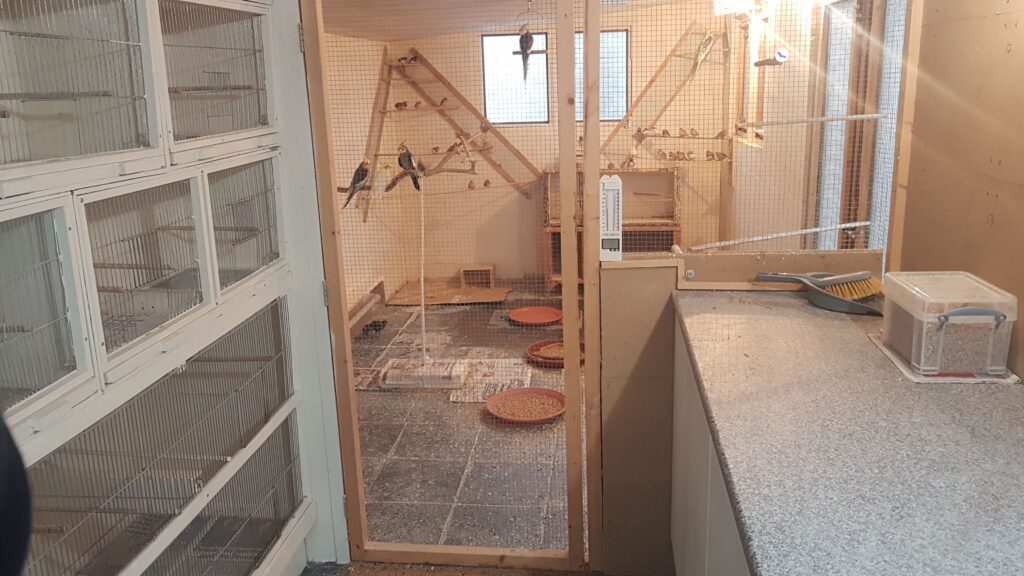
Prep space looking on into the internal bird aviary. 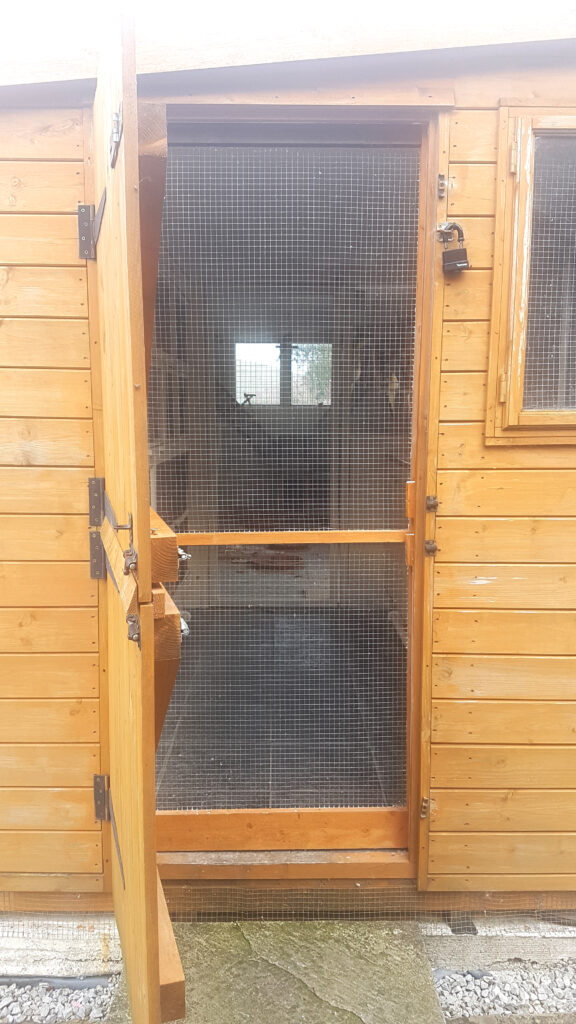
View from external wood door, to the safety mesh door. The internal bird space has a third door. 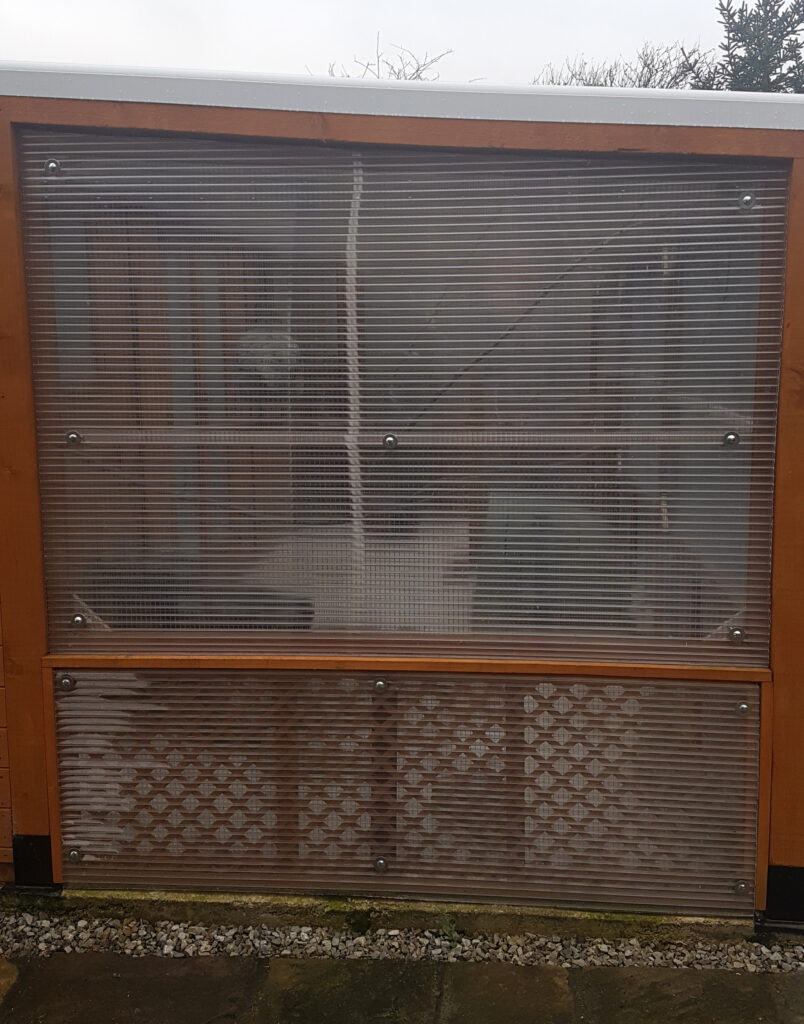
In winter the exterior is covered with polycarb sheets to protect the birds from the elements. 
In the harshest winter environment, birds can be contained in the indoor aviary space. 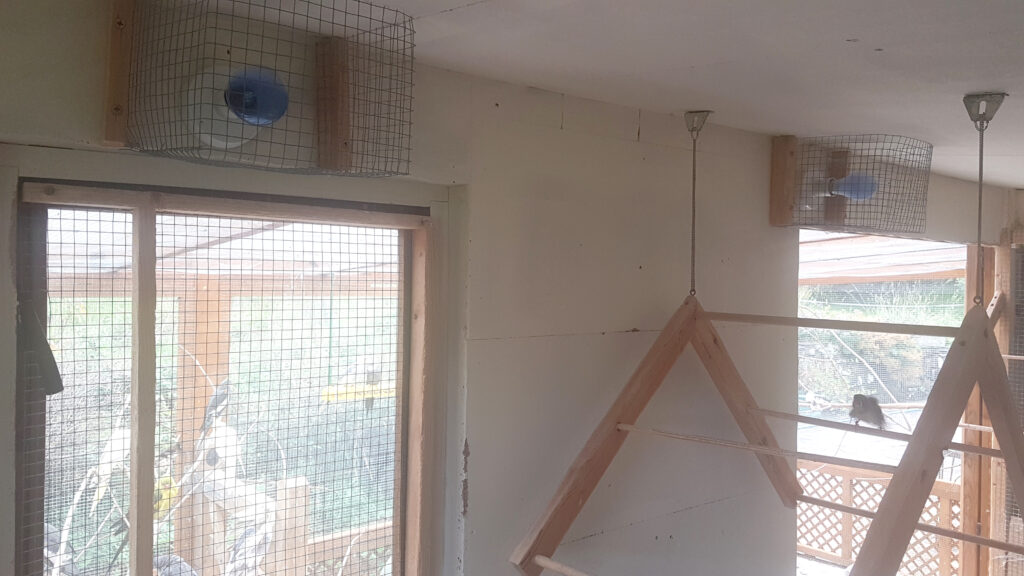
Full spectrum daylight bulbs are cage to prevent accidental burns. 
Lights are on a timer to ensure birds get enough daylight through the winter months. 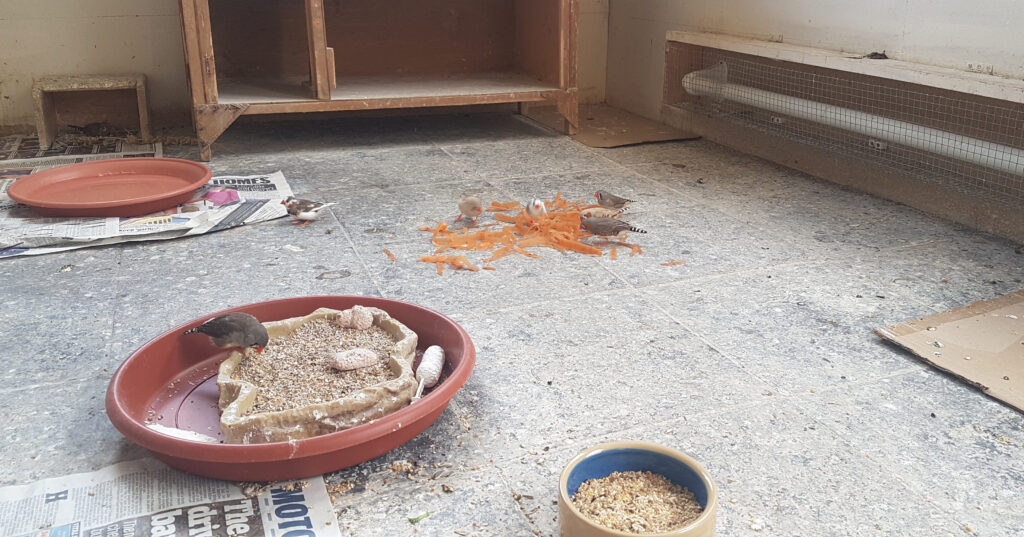
Food stations on the floor, are close to the heaters -which are caged to prevent accidental burns. 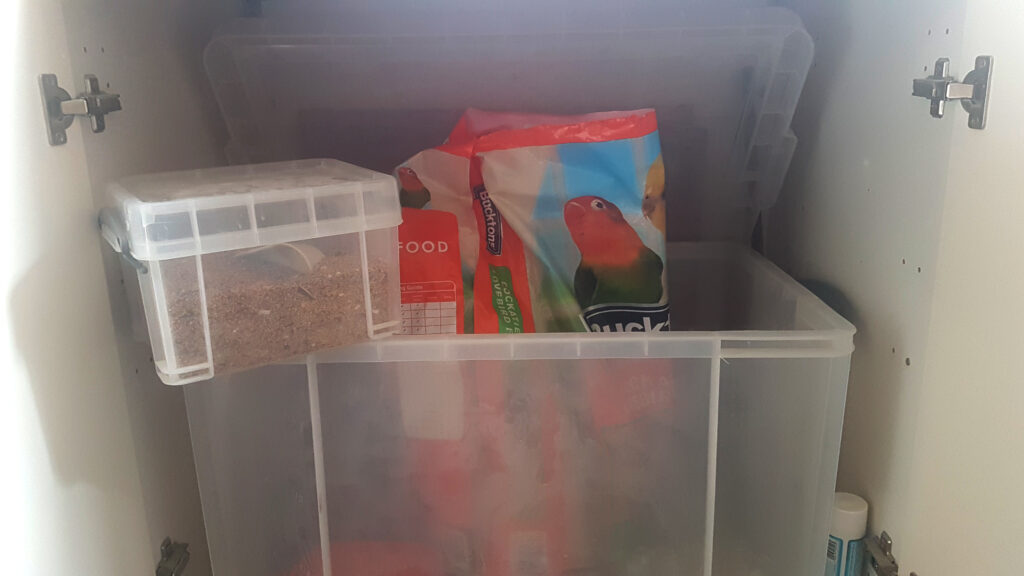
Food is contained in plastic boxes to discourage rodents. 
In the winter the solid roof provides a good insulation from the cold. It also stops debris from wild birds.
Design
So you’ve made it past the legal requirements, and you’ve decided on the size and location and have made sure the materials used in construction are 100% safe for you beloved bird. It is now time to begin planning the overall design. Not only should the aviary be safe and durable, but it should be tailored to the species of bird housed.
Exterior
The mesh used in the wall sections should be in two layers with the internal wire mesh being located a minimum of 5cm from the external wire mesh,
The mesh should be the appropriate thickness and size for the species of parrot housed. If you are housing a larger species of bird with a smaller species of bird the area of the wire mesh squares should be suitable to prevent the escape of the smaller bird however the thickness of the mesh should be durable enough to prevent the escape of the larger bird.
The frame can be made from thick lumbar or non-toxic metals however please note that lumbar frames will have a shorter lifespan due to it being an easy material to chew and more prone to weather damage as the wood must be untreated.
The aviary should have a solid construction roof, or a double meshed roof with a debris net on top. This is to prevent predator attack, and to protect from the presence of avian influenza in wild birds.
Ground
Soft ground flooring is aesthetically pleasing, and different layers of substrate can be used to provide a natural filter (use sandy soils not clay soils as the ground will become waterlogged).
- If pebbles/stones are used as the top layer they should be large enough to prevent your bird ingesting them.
- When using soft ground floors the wire mesh must be installed under the gravel layers to prevent predators digging under and gaining access to the aviary.
- Soft ground floors can be difficult to maintain. The use of a jet wash or hose and disinfectant is ideal however the ground may become waterlogged leading to bacterial build-up and potentially making the frame unstable.
- Food debris can be difficult to clear, attracting rodents and making contaminated/mouldy food readily available to your bird.
- Safe soft ground options include pre sterilized play sand or builders sand mixed with agricultural lime. The substrate can be disinfected regularly and can be sifted for food debris and droppings.
- Any soft ground flooring should be completely replaced every couple years or when necessary to ensure hygiene is maintained.
Cement ground floors are not as aesthetically however they are;
- Easy to disinfect
- Prevent predators accessing the aviary
- Longer lasting.
- Cement slabs may also be used, placed over a layer of gravel and sand to provide natural drainage.
- Cracks must be maintained as they will become a breeding ground for harmful bacteria.
- Concrete flooring must have an adequate drainage system to prevent the build-up of contaminated water when cleaning. Many parrots like to explore the ground, especially African Greys, and dirty, damp flooring can cause sores, burns to the soles of their feet and bumblefoot!
Security
Your aviary should have a double door system to prevent your birds from escaping, with at least one metre between the internal and external door, and an indoor or enclosed area to allow your bird to seek shelter from the scorching sun, torrential downpour and heavy winds, hail and snow.
Interior
Please do not provide a nesting box as this will encourage breeding behaviours. Instead provide an area to perch indoors which allow your birds to roost. This may be heated with the appropriate lamp or heater when the weather turns cold.
If the aviary is entirely indoors then full spectrum lighting should be installed to prevent vitamin D deficiency. In the wild different species are exposed to different UVB strengths nevertheless a lamp with 2.4% UVB and a 12% UVA output will be sufficient in replicating natural sunlight. When artificial light is provided it should only be turned on for eight to twelve hours of the day and fixed to the outside of the aviary to prevent the birds chewing on the wires.
Food and water points should be covered to prevent contamination from wild animal feces (particularly wild birds!) and debris. A separate drinking water point should be made available if there is also a bird bath in the enclosure, as although some parrots like to drink their own bath water it is always ideal to provide an alternative fresh source of water.
If you are housing a flock of birds in the aviary there should be multiple perching points and points of food and water to allow all birds access to the provisions.
Remember!
Don’t rush out and begin buying materials for your aviary, plan first as unexpected setbacks will occur.
It does not matter whether your bird only spends two hours of its day in the outdoor aviary or its entire day, the aviary should be safe and species specific!
Please take into consideration the species of birds and their individual personalities when birds in an aviary together to ensure they will be compatible with each other. A small timid budgie is not going to do well in an aviary with 6 other boisterous large macaws, especially if they have never been housed together before.
Further Reading
For information on aviary maintenance, decoration and enrichment in aviaries please see part 2 of this blog – aviary maintenance and enrichment
Designing an outdoor parrot flight or aviary
https://www.westminster.gov.uk/sites/default/files/guidance_notes_for_selling_animals_as_pets.pdf
https://www.nca.uk.net/factsheets/Fact_Sheet_03.pdf
TOXIC MATERIALS: http://myanimalandbird.com/wp-content/uploads/2019/08/How-to-Kill-Your-Birds-Without-Trying.pdf

